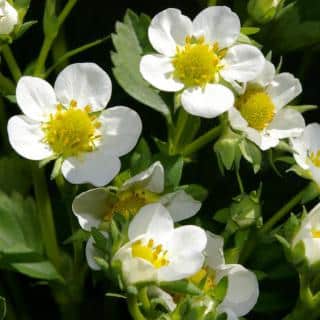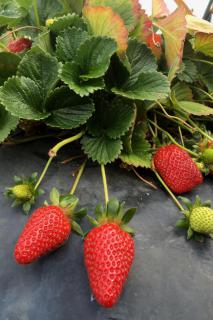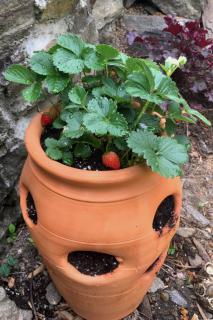

A strawberry plant produces fruits with a tender and fragrant flesh, which bring to mind thoughts of summer, sun and refreshing snacks.
Simple strawberry facts
Name – Fragaria vesca
Family – Rosaceae
Type – perennial fruit bush
Height – 6 to 16 inches (15 to 40 cm)
Exposure – full sun, part sun
Soil: rather rich, well drained – Foliage: deciduous – Harvest: May to October
Planting, caring, watering and even pruning strawberry bushes all contribute to increasing the harvest of strawberries.
 Strawberry plants sown as soon as the end of summer and during fall are guaranteed to produce strawberries in the following spring. September is often said to be the best month for planting.
Strawberry plants sown as soon as the end of summer and during fall are guaranteed to produce strawberries in the following spring. September is often said to be the best month for planting.
It is still possible to plant strawberries during the winter provided it doesn’t freeze.
If planting in the spring, begin adding strawberry plant fertilizer early April in order to stimulate the plant’s development.
It is necessary to provide for sufficient spacing between plants so that they may grow larger; a second reason for not crowding them together is that crowded plants tend to favor the spread of diseases.
Here is a tentative list of cultivars producing beautiful strawberries, grouped by harvest date and by certain characteristics.
 It is important to remove runners as they appear. Runners are long stems that take root and uselessly deplete the plant’s resources.
It is important to remove runners as they appear. Runners are long stems that take root and uselessly deplete the plant’s resources.
Mulch the base of the strawberry plants to retain soil humidity during the entire summer.
Apply treatments from early spring onwards against aphids and powdery mildew.
Strawberries require a lot of water and must be watered often, especially during heat waves.
Nonetheless, strawberry plants also are sensitive to too much water, which is why it is best to water often with reduced quantities.
During summer, it is best to water in the evening or early morning in order to keep water from evaporating immediately under the sun’s rays.
 If you have a terrace or balcony, it’s perfectly possible to grow your strawberries in pots or even in a planter box, to savor beautiful strawberries from spring to the end of summer.
If you have a terrace or balcony, it’s perfectly possible to grow your strawberries in pots or even in a planter box, to savor beautiful strawberries from spring to the end of summer.
If that is the case, it is better to plant well-formed plants purchased in stores directly in spring instead of fall, with a good mix of soil conditioner and soil.
As regards watering, ensure that the soil remains damp but never wet. The bottom saucer must not stay filled.
Pick your strawberries when you need them and as soon as they are ripe. A green strawberry can mature in just a few days.
There are 2 types of strawberry plants. One is the determinate type that only produces one cycle of strawberry production harvested over a 25 to 45-day period.
The second type of strawberry plants, called the indeterminate type, can produce starting in spring and continues producing flowers and fruits until the first fall frost spells.
Also pick those that aren’t as beautiful: they’ll keep attracting slugs, and you can still use them to make delicious jam.
Strawberry plants are generally sturdy and resist diseases and/or parasites well, and following these few tips will spare you many bad surprises.
In the fall, spray your strawberry plants with Bordeaux mixture after having removed root suckers and dried leaves.
One of the main parasites of strawberry plants will always be birds, which is why setting up a net is sometimes needed to protect the harvest.
– Red spider mites – common, and even more so during hot and dry years.
– Phytophtora blight (underground fungus) – gives leaves a blue-red color, before wilting when it gets hot. Plants stay fragile and fruits take on a bad taste.
– Botrytis – (or gray mold) covers leaves, flowers and ultimately fruits with a gray velvety layer. In this case, the fruits must be destroyed.
– Powdery mildew – a whitish powder spreads on and under leaves, which then curl into spoon-like shapes and take on a reddish hue. Fruits are stunted and deformed.
– Strawberry leaf scorch – develops on fruits that are ripening or already ripe.
– Septoria leaf spot on strawberry – spots appear on leaves. Avoid wetting leaves.
– Various viral infections – spread by aphids and contaminated neighboring plants. Leaves lose their shape, wrinkle, develop spots or stripes.
– Chlorosis – common in chalky or limestone soil.
It’s common knowledge that strawberry plants aren’t the hardiest of plants, and strong frost spells can damage your strawberry plot.
It’s recommended to mulch so that strawberries don’t touch the ground directly. Touching the soil directly would make them rot.
An alternative is to grow strawberries in pots, because the fruits themselves hang out from the sides and are never wet.